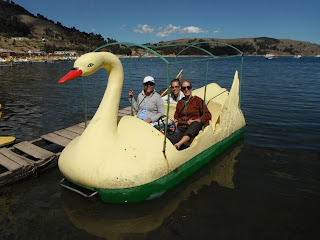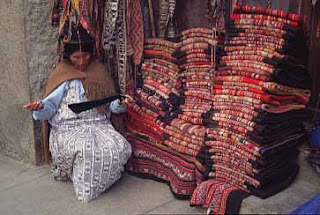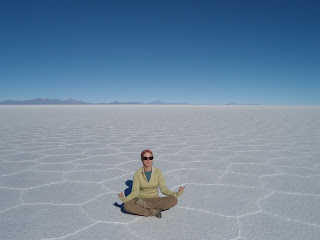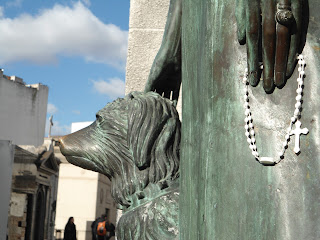Last week, my sister in law, Greta met us in La Paz. La Paz is a lovely city that sits in a "bowl" surrounded by mountains. Some of the city is built on steep hills, which makes you wonder what happens if a natural disaster happens. I love La Paz for its topography, the markets (which we spent 4 days at), and traditional culture. We spent our first few nights at "Loki Hostel", which was nice, but after 3 days there, we wanted a more "mellow" hostel, and one with a kitchen. We enjoyed our stay at "Adventure Brew Hostel" (mainly because we had our own room, which was nice after staying in a 14 bed dorm at the previous hostel).
We spent a day at the ruins in Tiwanaku , which we weren't too impressed by. Nonetheless, I still enjoyed the day out of the city, and riding in a microbus with locals. However, it has been a bit hard to to talk to the locals. I'm not sure if it is because it is a poorer country and the people have "pena" or perhaps they just don't like Americans. There is also a great possibilty they just don't understand my ghetto spanish. Despite the locals timid behavior towards us, Bolivia has been my favorite country so far. And it is also cheap as chips!
 |
| The witch market |
 |
| the crossing guards dressed as zebras |
 |
| practicing a way to earn my money in Bolivia (at the instrument museum) |
 |
| the view from Mirador Killi Killi |

Don't look down.
One of my favorite South American experiences thus far has been biking down "the world's most dangerous road", which is from La Paz to Coroico. We went through the most expensive company, Gravity Assistance Mountain Biking, which vale la pena, because we didn't die. The road had many beautiful views, in which, I didn't get to enjoy too much. As hard as it was to do, the main focus for me was to pay attention to my biking, and not at the beautiful scenery or the iridescent blue butterflies flying by. (There was a death due to a boy watching one fly past him as he was biking). 300-400 people die each year on this road. The last death was just last week (we saw the remains of the shattered car about 300 meters down.) They have just recently built a safer road to replace this road, but it is still used by many bikers and tourists who want to enjoy the experience on this beautiful, yet dangerous road.
We are currently at Lake Titikaka, which is on the border of Bolivia and Peru. It is the largest lake in South America and the highest lake in the world.
 |
| Lake Titikaka |















































